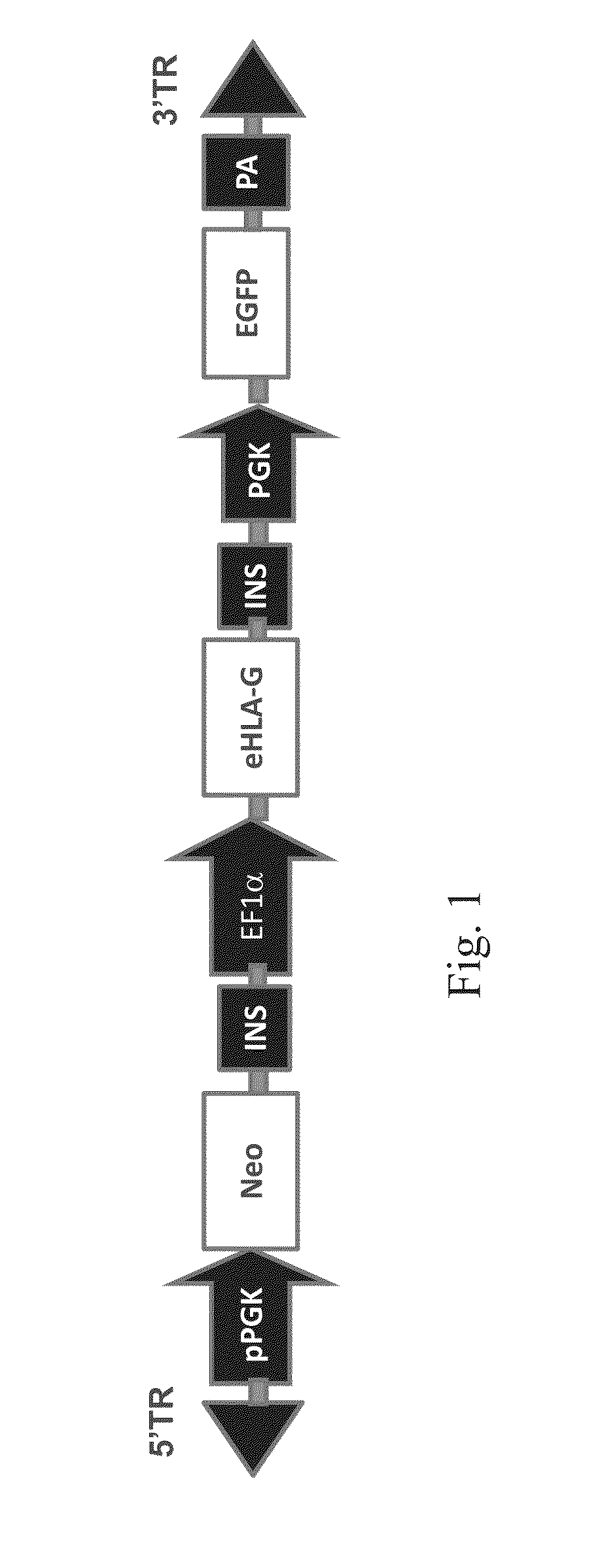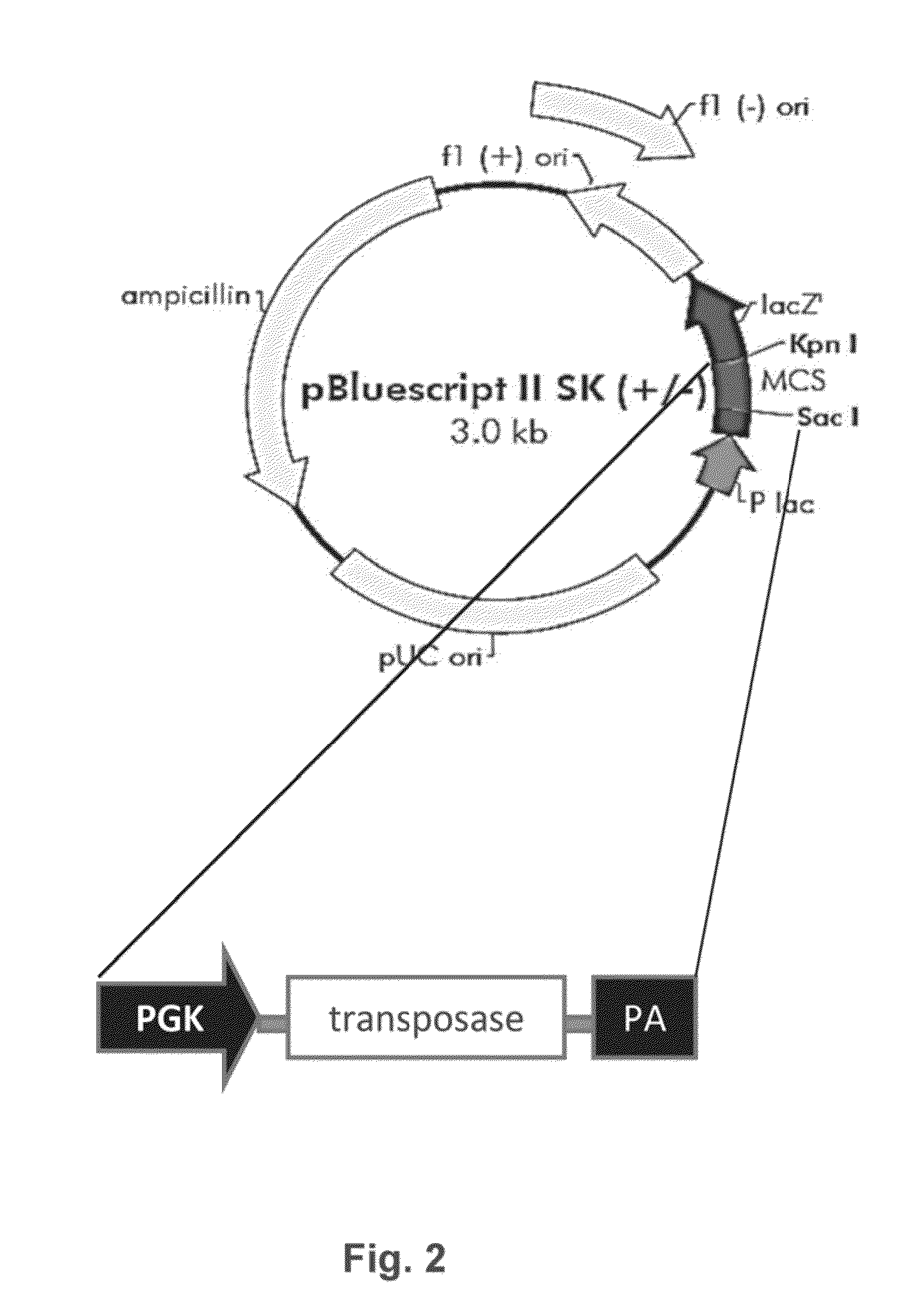HLA g-modified cells and methods
- Summary
- Abstract
- Description
- Claims
- Application Information
AI Technical Summary
Benefits of technology
Problems solved by technology
Method used
Image
Examples
example 1
Identification of Gene Expression Patterns Associated with Immune Tolerance of Cancer Cells
[0113]Human soft tissue cancer arrays were initially screened in search of a candidate immune tolerance gene that showed increased expression with cancer progression to metastatic states, presumably due to evasion of immune surveillance mechanisms. The data revealed a strong positive correlation between successful metastasis and expression levels of several genes previously implicated in the immune tolerance. To assess whether MSCs could induce immune tolerance and allograft acceptance, MSCs were cross-screened by RT-PCR to examine the expression levels of these candidate genes and several antigenic HLAs. Table 1 illustrates that passage 1 MSCs expressed HLA class Ia, HLA-G and II markers in addition to CD200, CD47, and indoleamine 2,3-dioxygenase (IDO). It was found that a population of MSCs expressed HLA-G at moderate levels, albeit less than that found for Jeg-3, a cancer line with aggressi...
example 2
Culture and Differentiation of Human Embryonic Stem Cells into Human Epidermal Progenitors (hEEPs)
[0117]All tissue culture reagents were from Life Technologies unless otherwise specified. ESC growth medium contains DMEM / F12 (1:1) supplemented with 20% knockout serum replacement, 0.1 mM MEM non-essential amino acids, 1 mM GlutaMax, 0.1 mM β-mercaptoethanol (Sigma). ESC growth medium was conditioned by plating mitotically inactivated mouse embryonic fibroblasts (MEFs) (CF-1, ATCC) at a density of 5×104 cells / cm2 and incubating for 18-24 hours. After conditioning, 4 ng / ml bFGF was added and complete conditioned medium was sterile filtered. hESCs were subcultivated every 5-6 days (1:3 or 1:4 split) on Matrigel-coated plates using 1 mg / ml Dispase to remove cell colonies. K14+ / p63+ hEEPs were generated according to the method of Metallo et al supra. Briefly, hESCs were cultured in 6-well plates for 4 days and then treated with 2 ml / well of differentiation medium, comprised of unconditione...
example 3
eHLA-G Construct Design and Stable Expression in hESCs
[0121]A novel HLA-G construct was designed by combining multiple modifications: 1) mutation of HLA-G's ER retrieval motif (K334A / K335A); and 2) mutation of HLA-G's 3′ UTR microRNA binding sites. Since viral gene delivery systems remain a serious regulatory challenge, the PiggyBac system was used, a transposon-based, nonviral approach that was recently shown to achieve a 90% transfection efficiency in H1 hESCs (Lacoste et al (2009), Cell Stem Cell, 5:332-342.). This system requires a donor plasmid containing the transposon (FIG. 1A) and a helper plasmid expressing the transposase (FIG. 2). To generate helper plasmids, the ePiggyBac codon humanized transposase cDNA was custom synthesized (GeneArt) and then cloned in pBluescript (Stratagene) downstream of a PGK promoter and upstream of an SV40 polyadenylation signal sequence (pA). For the eHLA-G expression cassette, multiple promoters were compared including the M-U3 / R promoter, MSC...
PUM
| Property | Measurement | Unit |
|---|---|---|
| Fraction | aaaaa | aaaaa |
| Fraction | aaaaa | aaaaa |
| Time | aaaaa | aaaaa |
Abstract
Description
Claims
Application Information
 Login to View More
Login to View More - R&D
- Intellectual Property
- Life Sciences
- Materials
- Tech Scout
- Unparalleled Data Quality
- Higher Quality Content
- 60% Fewer Hallucinations
Browse by: Latest US Patents, China's latest patents, Technical Efficacy Thesaurus, Application Domain, Technology Topic, Popular Technical Reports.
© 2025 PatSnap. All rights reserved.Legal|Privacy policy|Modern Slavery Act Transparency Statement|Sitemap|About US| Contact US: help@patsnap.com



